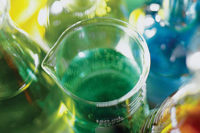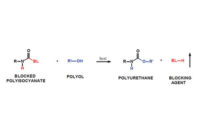Q&A About Polyurethanes
What are the advantages of using polyurethane technology for hot-melt applications?

I am familiar with traditional ethylene vinyl acetate (EVA), polyester and polyamide (PA)-based hot-melt adhesives.
What are the advantages of using polyurethane technology for hot-melt applications?
EVA, PA and polyester hot-melt adhesives have been successfully used for many years; each has advantages for specific applications and markets. EVA-based hot melts are general-purpose products whose applications are limited by a relatively low upper use temperature (60-80°C). Polyamides and polyesters are higher performance products with superior elevated temperature properties, but the application temperatures required (~ 200°C) are quite high, which can be an issue for substrates that are temperature sensitive.
Polyurethane hot-melt adhesives fall into two categories: thermoplastic or thermoset. Both have strong adhesion to a many substrates, are used at lower temperatures than polyamides and polyesters, and exceed EVA performance. The thermoplastic polyurethanes are linear high-molecular-weight polymers. They are supplied as either pellets or powders, and are mainly used for textile applications. The pellets can be extruded into non-tacky free-standing films or can be coated directly onto a substrate. The pellets are supplied with a minimal gel content to prevent film defects. The bonding process involves briefly exposing the films to mild temperatures of ~ 60-75°C, which exceeds the polymer’s crystalline melting temperature (Tm). A tacky film results and the substrates are bonded.
Thermoplastic powders are used in a scatter coating process. These polymers are composed of crystalline polyester polyols and most often 4,4’-diphenylmethane diisocyanate (MDI). The temperature to activate the films, the open time between activation and use, and heat resistance are primarily determined by the polyester polyol used.
Polyurethane reactive hot melts are isocyanate-terminated prepolymers that cure by the reaction with water to form high-molecular-weight polymers containing urea bonds. This reaction takes place over a number of days at room temperature, but can be accelerated by humidity, the water content of the substrate, or by tin or amine catalysts. The resulting thermoset polymer has a higher heat resistance than thermoplastic counterparts. The isocyanate content, which is determined by the isocyanate/hydroxyl ratio, is typically 1-4%. The prepolymers are solid at room temperature, but their low molecular weight permits a processing temperature of ~ 120°C. The free isocyanate content promotes adhesion.
Polyurethane reactive hot melts are composed of the same type of raw materials used in the thermoplastic hot melts: di-functional polyisocyanates and polyols. The isocyanate is typically 4,4’-MDI, but the unsymmetrical 2.4’-isomer can be used to disrupt crystallinity and extend the open time. Crystalline polyesters based on adipic acid and butane or hexanediol are primarily used as the hydroxyl component and promote fast development of bond strength by recrystallization of the prepolymer from the molten state. The recrystallization rate can be further accelerated, and the development of green strength can be optimized by incorporating polyester polyols into the prepolymer with a high molecular weight (low hydroxyl number) or those containing the specialty carboxylic acids (sebacic or dodecandioic). The open time can be extended by adding amorphous polyester or polyether polyols.
Commercial hot melts have been formulated to produce open times from five seconds to 10 minutes, and are available in packages ranging from 10-oz tubes to 55 gal drums. They have found use in textile, automotive and construction applications.
Any views or opinions expressed in this column are those of the author and do not represent those of ASI, its staff, Editorial Advisory Board or BNP Media.
Looking for a reprint of this article?
From high-res PDFs to custom plaques, order your copy today!






